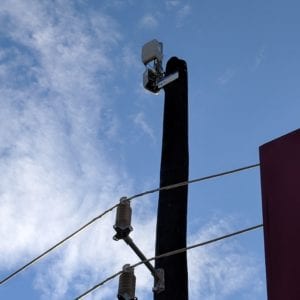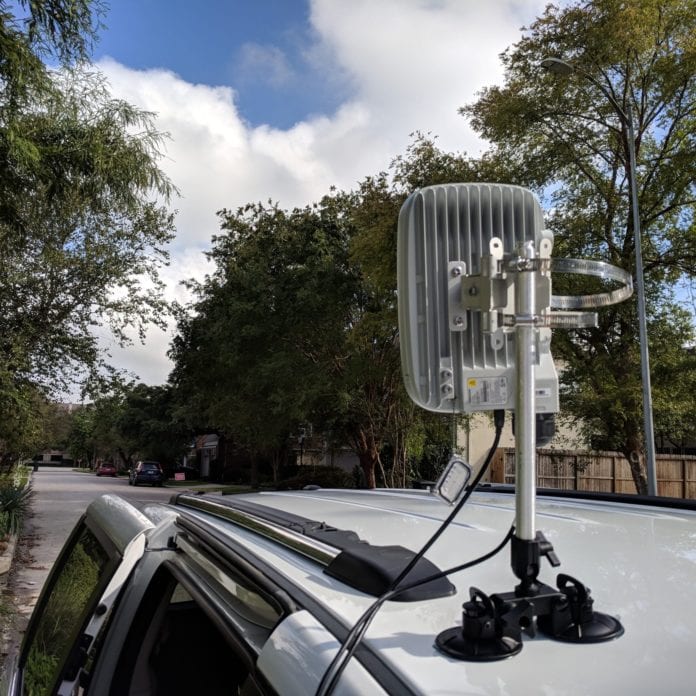Verizon’s official launch of its 5G fixed wireless access service is only two days old, but Mike Thelander and Emil Olbrich of Signals Research Group are already on the ground in Houston, Texas, field-testing the live network’s capabilities.
Houston is one of four initial launch markets for the Verizon 5G Home internet service. Speaking to RCR Wireless News from Houston, Thelander, CEO and founder of SRG, started off with the caveat that he hasn’t had a chance to analyze the data yet, so his remarks were observational — but nonetheless said that Verizon’s 5G TF radio interface at 28 GHz is performing as-advertised, and in fact described the 5G TF air interface as “very phenomenal.”
Thelander said that he and Olbrich have been testing both the outdoor and indoor CPE, driving around the Houston area to locate 5G access points and then conduct testing under a variety of scenarios: line-of-

sight and non-line-of-sight, with trees and buildings between the CPEs and the 5G TF cell sites. Verizon, he noted, has been hands-off other than providing the CPEs and nudging the two in the general direction of some sites.
SRG had previously conducted similar independent testing of Verizon’s 5G TF test network earlier this year and found that the millimeter-wave signals were much more resilient than expected at distances of up to several thousand feet from a site and in challenging non-line-of-sight conditions. Though the results from this week’s testing aren’t officially in, Thelander said they saw much the same signal behavior on the live 5G TF network.
“We’re definitely seeing the data speeds that they advertise,” Thelander said. The bigger thing, he went on, is that SRG is seeing that same unexpectedly robust signal propagation in the live network. “We’re seeing the exact same thing, but this time with actual data speeds,” Thelander said. “We can be sitting literally behind a building and have a whole block of trees and no visibility to the cell site, and we’re still seeing hundreds and hundreds of megabytes in the downlink and just slightly lower in the uplink.”
The other notable thing that emerged in SRG’s early observations, Thelander said, is that where speeds are limited, it’s not because of the 5G TF air interface.
“What we’re seeing consistently is that … you’re limited by the application you’re using or the internet itself, and not the 5G network,” Thelander said. He described scenarios where SRG might see speeds around 800 Mbps on the 5G connection itself — but when they would access an application such as Google Drive for downloading files to perform customer-experience type of tests, speeds were much slower: on the order of 200 to 300 Mbps.
“There’s a big difference there, but the limitation really has nothing to do with the Verizon network,” he noted. The other limitation that customers are likely to run into, he added, is the speed supported by their physical Ethernet connection from their router, rather than the air interface itself.
“The air interface for 5G TF is very phenomenal, and all the limitations we’re seeing by and large lie elsewhere,” Thelander concluded.
Olbrich, VP of networks for SRG, said that while SRG conducted some testing close to the small cell sites (within about 50 feet), “most of our testing is in challenging environments, more realistic — what a consumer would see with their desk-top box or outdoor-mounted unit.” He reported that SRG was seeing speeds on the order of 600 to 800 Mbps on the downlink and 250 Mbps on the uplink — on an unloaded network, to be sure, but still good performance. In terms of available spectrum, Olbrich said that Verizon had 400 megahertz of 28 GHz deployed during SRG’s first testing in the area earlier this year and has now ramped that up to 600 megahertz: six 100-megahertz channels.
As far as the physical site installations, Thelander said that unlike the test network site which SRG put through its paces — which was mounted on a macro tower — “everything we’ve seen so far … are small cells.” Thelander described the equipment as one- or two-sector small cells. Olbrich added that all the sites SRG has observed have been on wooden utility poles, placed at the top of the poles with elevations somewhere around 20 to 40 feet high.
Despite the shorter heights, Thelander said, even when SRG is half a dozen blocks away in “quasi-line-of-sight” conditions, where many would be skeptical of receiving a millimeter-wave signal at all, he and Olbrich are still seeing speeds in the low-hundreds of megabytes per second.
Thelander said that compared to other mounted equipment such as transformers and security cameras, the small cell sites “are hidden to a large extent. … They’re small enough that you wouldn’t know it was there unless you saw them install it.” He compared the size of the tower-top boxes to a notebook computer.
To conduct their testing, Thelander and Olbrich relied on Samsung customer premise equipment provided to them by Verizon (a router and 5G indoor and outdoor modems), four PCs plugged into the equipment and a test solution from Accuver that allows SRG to pull 5G chipset-level information from the CPEs.
Thelander noted that SRG will come out with a detailed report once it has completed its data analysis.

